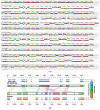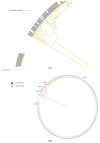Characterization of Bordetella pertussis Strains Isolated from India
- PMID: 35890038
- PMCID: PMC9322502
- DOI: 10.3390/pathogens11070794
Characterization of Bordetella pertussis Strains Isolated from India
Abstract
Despite high level vaccination and the availability of two different types of vaccines, whole cell (wP) and acellular vaccines (aP), the resurgence of pertussis has been reported in many countries. Antigenic variation within circulating and vaccine strains is the most documented reason reported for the resurgence of pertussis. Research on genetic divergence among circulating and vaccine strains has largely been reported in countries using aP vaccines. There are inadequate data available for antigenic variation in B. pertussis from wP-using countries. India has used wP for more than 40 years in their primary immunization program. The present study reports five clinical isolates of B. pertussis from samples of pediatric patients with pertussis symptoms observed in India. Genotypic and phenotypic characterization of clinical isolates were performed by serotyping, genotyping, whole genome analyses and comparative genomics. All clinical isolates showed serotype 1, 2 and 3 based on the presence of fimbriae 2 and 3. Genotyping showed genetic similarities in allele types for five aP genes within vaccine strains and clinical isolates reported from India. The presence of the ptxP3 genotype was observed in two out of five clinical isolates. Whole-genome sequencing was performed for clinical isolates using the hybrid strategy of combining Illumina (short reads) and oxford nanopore (long reads) sequencing strategies. Clinical isolates (n = 5) and vaccine strains (n = 7) genomes of B. pertussis from India were compared with 744 B. pertussis closed genomes available in the public databases. The phylogenomic comparison of B. pertussis genomes reported from India will be advantageous in better understanding pertussis resurgence reported globally with respect to pathogen adaptation.
Keywords: Oxford sequencing; allele; developing country; genetic divergence; genotype; phylogeny; vaccines; whooping cough.
Conflict of interest statement
The authors declare no conflict of interest.
Figures



References
LinkOut - more resources
Full Text Sources
Molecular Biology Databases

